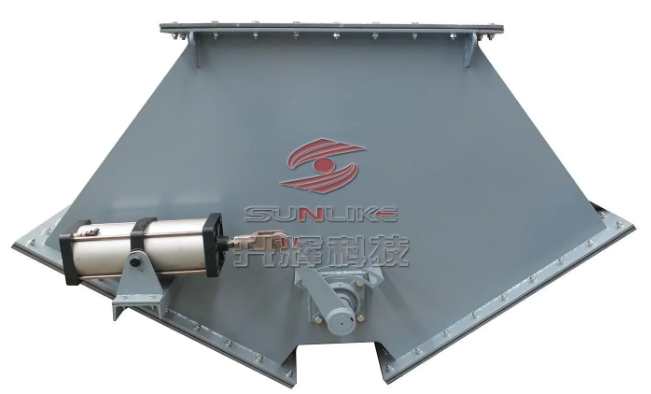- This topic is empty.
-
AuthorPosts
-
2025-10-28 at 10:50 am #4886
Positive three-way dispensing valves are critical components in industries such as cement, metallurgy, ports, mines, and environmental protection. They allow precise control of material or fluid flow direction, ensuring operational efficiency, safety, and product quality. However, improper use, mechanical wear, or unsuitable installation can lead to operational issues. Understanding the underlying causes, preventive measures, and effective fixes is essential for industrial engineers, maintenance teams, and project managers.
1. Understanding the Design and Functionality of Positive Three-Way Dispensing Valves
Before addressing troubleshooting, it’s important to understand the valve’s working principle. A positive three-way dispensing valve typically consists of:
-
Valve body: High-strength steel or alloy to withstand abrasive or corrosive materials.
-
Rotary or sliding core: Directs flow between multiple outlets.
-
Seals and gaskets: Prevent leakage while enduring high pressure and temperature.
-
Actuators (manual, hydraulic, pneumatic, or electric): Control the valve’s position accurately.
Industrial Insight: In bulk material handling lines, such as cement or mineral plants, the valve ensures precise routing between storage, homogenization, and loading systems. Sunlike integrates these valves with automated control systems for real-time monitoring and optimal flow management.

2. Common Issues and Their Causes
2.1 Leakage at Seals or Connections
Causes:
-
Worn-out or damaged seals.
-
Misaligned installation or improper torque.
-
Material incompatibility with the conveyed medium.
Fixes:
-
Inspect and replace seals regularly.
-
Verify alignment and torque during installation.
-
Select materials compatible with corrosive or abrasive media.
2.2 Flow Blockage or Clogging
Causes:
-
Residual material buildup.
-
Abrasive particles causing wear and irregular flow.
-
Lack of regular cleaning or pre-filtration.
Fixes:
-
Implement routine cleaning and maintenance schedules.
-
Install screens or filters upstream to prevent large particles.
-
Inspect valve passages and replace worn components.
2.3 Difficulty Switching Flow Direction
Causes:
-
Mechanical wear on internal components.
-
Insufficient lubrication.
-
Miscalibrated actuators or automation systems.
Fixes:
-
Replace worn internal parts and apply proper lubrication.
-
Calibrate actuators or control devices according to operational requirements.
-
Upgrade to reinforced or precision-engineered internal components for high-stress applications.
2.4 Pressure Drop Across the Valve
Causes:
-
Internal corrosion or wear.
-
Incorrect valve sizing relative to system demand.
-
Accumulated debris or material compacting inside the valve.
Fixes:
-
Inspect and clean internal passages.
-
Ensure proper valve selection based on flow rate and pressure requirements.
-
Use corrosion-resistant materials for long-term performance.
2.5 Unintended Flow or Drifting
Causes:
-
Actuator failure or hydraulic/pneumatic inconsistencies.
-
Loose mechanical connections.
-
Valve seat deformation or internal wear.
Fixes:
-
Conduct regular actuator performance checks.
-
Tighten and secure all mechanical and control connections.
-
Replace worn or deformed valve seats.
3. Preventive Maintenance and Optimization Strategies
-
Scheduled inspections: Regular checks of seals, actuators, and valve bodies prevent downtime.
-
Material selection: Use wear-resistant and corrosion-resistant alloys to extend valve life.
-
Integration with automation: Sensors and PLC-controlled actuators allow predictive maintenance and real-time diagnostics.
-
Training personnel: Skilled operators reduce misuse and human error.
Sunlike Advantage: Our engineering team provides tailored solutions, including reinforced internal components and automation integration for bulk material handling, dust removal, and cement processing lines, ensuring high reliability.
4. Industrial Applications Beyond Basic Flow Control
Positive three-way dispensing valves are not limited to simple routing—they support complex industrial operations:
-
Cement and mining: Routing raw materials between storage, grinding, and homogenization systems.
-
Environmental protection: Managing flue gas exhaust lines and dust control systems.
-
Ports and logistics: Directing bulk materials for loading/unloading processes.
-
Energy projects: Controlling materials in renewable energy or power plant operations.
Design Insight: Customizable valve specifications, combined with Sunlike’s electromechanical control expertise, allow integration into projects with unique dimensions, flow rates, or abrasive materials.
5. Choosing the Right Valve for Your Project
-
Evaluate material compatibility and abrasion resistance.
-
Confirm actuator type (manual, electric, pneumatic) fits your automation system.
-
Verify size and pressure rating for system requirements.
-
Consider integration with real-time monitoring or automation platforms.
Tip: Partnering with a qualified supplier like Sunlike ensures professional design, manufacturing, and support for custom industrial applications.
Conclusion
Positive three-way dispensing valves are central to efficient, safe, and precise material handling in diverse industrial environments. By understanding common issues—leakage, clogging, actuator failure, pressure drops, or unintended flow—and applying preventive measures, maintenance teams can extend valve life and maintain process reliability.
Sunlike combines advanced valve engineering with comprehensive automation solutions for bulk material handling, cement, environmental protection, and mining projects. Our expertise in custom designs and high-quality components ensures industrial operations run smoothly, safely, and efficiently.
http://www.cn-sunlike.com
Nantong Sunlike Machinery Co., Ltd. -
-
AuthorPosts
- You must be logged in to reply to this topic.
